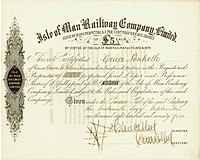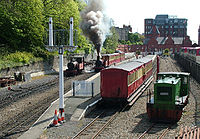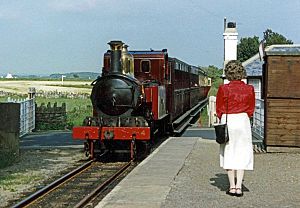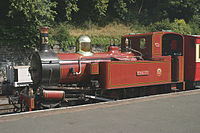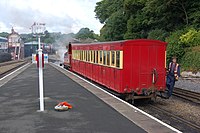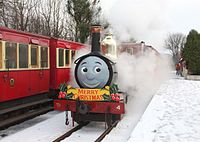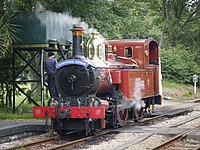Difference between revisions of "Isle of Man Railway"
(Created page with "{{Infobox heritage rail |name=Isle of Man Railway |manx=Raad Yiarn Vannin |territory=Isle of Man |picture=Castletown Water Tower.JPG |picture caption=Locomotive taking water a...") |
m (→History) |
||
| Line 17: | Line 17: | ||
==History== | ==History== | ||
[[File:Isle of Man Railway 1875.jpg|left|thumb|200px|Share of the Isle of Man Railway Company Ltd, issued 16. September 1875]] | [[File:Isle of Man Railway 1875.jpg|left|thumb|200px|Share of the Isle of Man Railway Company Ltd, issued 16. September 1875]] | ||
| − | The | + | The fifteen-and-a-half-mile line from Douglas to Port Erin is the last remaining line of the former Isle of Man Railway Company, formed in 1870. Its first line, from [[Douglas, Isle of Man|Douglas]] to [[Peel, Isle of Man|Peel]], opened on 1 July 1873, followed by the Port Erin line on 1 August 1874. Initially the Port Erin line had been planned to terminate at [[Castletown, Isle of Man|Castletown]], but the construction of deep water docks at Port Erin brought an extension to the line. A few years after completion, the dock was destroyed by heavy seas and the idea of deep water vessels abandoned there. The remains of the breakwater are still visible at low tide. |
A third line was built in 1878–1879 by the Manx Northern Railway, from [[St John's, Isle of Man|St John's]] (on the Douglas to Peel line) to [[Ramsey, Isle of Man|Ramsey]]. A further short line was constructed from St John's to Foxdale in 1885 to serve the lead mines there. Although it was built by the nominally independent Foxdale Railway, it was leased to and operated by the Manx Northern. The loss of the mineral traffic from Foxdale and competition for the Douglas-Ramsey passenger traffic from the [[Manx Electric Railway]] placed the Manx Northern Railway in financial difficulties. It was taken over by the IMR in 1904. | A third line was built in 1878–1879 by the Manx Northern Railway, from [[St John's, Isle of Man|St John's]] (on the Douglas to Peel line) to [[Ramsey, Isle of Man|Ramsey]]. A further short line was constructed from St John's to Foxdale in 1885 to serve the lead mines there. Although it was built by the nominally independent Foxdale Railway, it was leased to and operated by the Manx Northern. The loss of the mineral traffic from Foxdale and competition for the Douglas-Ramsey passenger traffic from the [[Manx Electric Railway]] placed the Manx Northern Railway in financial difficulties. It was taken over by the IMR in 1904. | ||
Latest revision as of 20:35, 24 December 2018
| Isle of Man Railway Manx: Raad Yiarn Vannin | |
|
Isle of Man | |
|---|---|
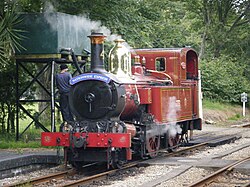 Locomotive taking water at Castletown | |
| Gauge: | 3 feet |
| Track: | 15½ miles |
| Information | |
| Owned by: | Department of Infrastructure |
| Website: | //rail.im |
The Isle of Man Railway is a narrow gauge steam-operated railway connecting Douglas with Castletown and Port Erin on the Isle of Man. The line is a 3-foot narrow gauge and 15.3 miles long.
This railway is the remainder of what was a much larger network (over 46 miles in length) that also served the western town of Peel, the northern town of Ramsey and the small mining village of Foxdale. Now in government ownership, it uses original rolling stock and locomotives and there are few concessions to modernity.
Contents
History
The fifteen-and-a-half-mile line from Douglas to Port Erin is the last remaining line of the former Isle of Man Railway Company, formed in 1870. Its first line, from Douglas to Peel, opened on 1 July 1873, followed by the Port Erin line on 1 August 1874. Initially the Port Erin line had been planned to terminate at Castletown, but the construction of deep water docks at Port Erin brought an extension to the line. A few years after completion, the dock was destroyed by heavy seas and the idea of deep water vessels abandoned there. The remains of the breakwater are still visible at low tide.
A third line was built in 1878–1879 by the Manx Northern Railway, from St John's (on the Douglas to Peel line) to Ramsey. A further short line was constructed from St John's to Foxdale in 1885 to serve the lead mines there. Although it was built by the nominally independent Foxdale Railway, it was leased to and operated by the Manx Northern. The loss of the mineral traffic from Foxdale and competition for the Douglas-Ramsey passenger traffic from the Manx Electric Railway placed the Manx Northern Railway in financial difficulties. It was taken over by the IMR in 1904.
During the mid-1920s the IMR formed a bus subsidiary that operated most of the island's bus services, and helped the railway to remain profitable into the 1960s. The first serious examination of the long term viability of the railway came with the Howden Report in 1949, which recommended the closure of the Ramsey line, which was already losing money; the eventual closure of the Peel line, which was breaking even in the late 1940s; and the retention of the then profitable Port Erin line. Howden also reported that the existing equipment of the railway had an economic life of 10–25 years. Economies were made throughout the 1950s and early 1960s. These included the ending of evening and Sunday services, the deferral of track maintenance, and cuts to train mileage as locomotives became unserviceable. To further reduce expenses, there were winter closures of the Peel line (1960-61 only) and the Ramsey line after September 1961, but A. M. Sheard, the then general manager, refused to close the Ramsey line which by this time was losing a considerable amount of money each year.
Following the closure of the County Donegal Railways in 1960, the IMR purchased the CDR's two most modern diesel railcars, which were then largely used on the Peel line in summer, and after 1962 worked the whole of the winter service except when withdrawn for maintenance. The system closed after the 1965 season but was briefly revived when Archibald Kennedy, 7th Marquess of Ailsa obtained a lease and reopened all three routes in 1967.[1] Both the Peel and Ramsey lines shut following the 1968 season, but goods services between Peel and Milntown (just short of Ramsey) continued until mid-1969. Traffic was poor on the two northern lines, especially that to Ramsey, so after the end of the 1968 season, Ailsa decided to concentrate on passenger service on the South Line for three more seasons until he took the option to end his lease at the close of the 1971 season.
There were occasional empty coaching stock workings between Douglas and St John's in 1970 and 1971 for the retrieval of stored stock between seasons. During this time most of the early wooden framed carriages were moved to St John's, where they were lost in a fire in July 1975. The Peel and Ramsey routes and the Foxdale line were lifted in 1975. The IMR operated services between Douglas and Port Erin after Lord Ailsa took his five-year option, beginning in 1972 through the centenaries of the Peel and Port Erin lines in 1973 and 1974 respectively. In 1975, the Port Erin line operated only from its southwestern terminus to Castletown, but it was found that half a railway made twice the loss. The government sponsored a short extension of the service from Castletown to Ballasalla in 1976, and, after extensive campaigning during the 1976 Tynwald elections, the railway returned to Douglas in 1977, the last year in which the railway was operated by the IMR. Following nationalisation the railway has continued to be operated seasonally, for many years from Easter weekend until the end of September, more recently from around 1 March to early November.
Ownership
Formed in 1870 with the first line following three years later, the Isle of Man Railway Company operated services until 1977 (see below) merging with the Manx Northern Railway and Foxdale Railway in 1905. The railway is now marketed as the Steam Railway to differentiate it from the Manx Electric Railway, operated by the same department. It was marketed as "Isle of Man Railway" until closure in 1965. From 1969 to 1972, it operated as the Isle of Mann Victorian Steam Railway Company Limited, reverting to Isle of Man Railway. When nationalised in 1978 it fell under the banner of "Isle of Man Railways", along with the Manx Electric Railway. Re-branding to Isle of Man Passenger Transport took place from 1984 but the steam line was not affected, and this reverted to Isle of Man Railways from 1990, when a re-branding exercise took place with the emphasis on the Victorian origins of the railway. A change in management style occurred in 1999, and trains, trams and buses were presented as Isle of Man Transport. The electric railway was affected more by this change, with a series of non-historical and modern liveries, but in 2007 this was changed and the railway is marketed once more as the Isle of Man Railway. In keeping with the historical aspect, coaches and locomotives carry original names and transfers. The banner heading of all the railways was again changed in 2009 and became collectively known as Isle of Man Heritage Railways, although the "heritage" tag has been dropped latterly. Joint timetabling with the Manx Electric Railway sees the line titled as the Steam Railway in marketing material.
South Line described
Today's railway is a fraction of its original size: it once served the western town of Peel, the northern town of Ramsey and the small mining village of Foxdale. Since 1969 only the southern line has been operational. Although it is only about half of its former size, Douglas railway station is still an impressive complex. After crossing the River Douglas, the line climbs the two-and-a-half-mile-long 1-in-65 Nunnery Bank through a wide rock cutting that brings it through a large estate, and past an industrial estate to the White Hoe, where the island's largest brewery is passed on the left of the train before crossing the first bridge. The train continues to climb to Port Soderick, just before which passengers get the first view of the sea at Keristal, before descending into the railway station. The train then passes through Crogga Woods, under another bridge at Meary Veg (centre for the island's sewage treatment works) and climbs, reaching its summit (588.0 feet (179.2 m), marked by a board visible from the train) close to the site of Ballacostain Halt. The train descends to Santon, the only intermediate station in substantially original condition. From here the train descends at 1 in 60 to Ballasalla railway station, with interesting sea-cliff views to the east. Regular service trains formerly passed each other here. After Ballasalla the line runs over relatively flat land past the request halt at Ronaldsway to the ancient capital of Castletown.
After Castletown the railway crosses the Silver Burn and heads northwest across country to the diminutive request stop at Ballabeg station. It then turns west for the short run to Colby, which is popular with the locals. After a request stop at the Level the train continues to Port St Mary, with views of Bradda Head and Milner's Tower on this stretch of line to Port Erin. Port Erin railway station is home to the Whistle Stop Cafe, providing light refreshments, and the Isle of Man Railway Museum, established in 1975 with two locomotives and rolling stock including the Queen's Coach and Governor's Saloon from the opening of the line in 1873.
The majority of the line runs through countryside, with only small stretches close to built-up areas. Many people start or end their journey in Port Erin, a Victorian seaside resort, or in Castletown, the ancient capital. Ronaldsway Halt, between Ballasalla and Castletown, is a few hundred yards' walk from the airport. There are several farm crossings and rural request stops, which largely serve adjoining fields and local communities, especially on the southernmost section which passes through agricultural land. The line passes along the southern plain following the more hilly landscape north of Ballasalla.
Locomotives
All but one of the railway's distinctive locomotives were built by Beyer, Peacock and Company of Manchester between 1873 and 1926, with 16 steam locomotives in total. As of October 2018 there are nominally four locomotives in traffic: № 8 Fenella, № 12 Hutchinson, № 13 Kissack and № 15 Caledonia. In addition, № 11 Maitland is undergoing a long-term rebuild, whilst № 4 Loch and № 10 G. H. Wood are both undergoing overhaul. The Isle of Man Railway Museum is home to № 6 Peveril of 1875 and № 16 Mannin of 1926, with other locomotives at various locations. Only № 2 Derby has been lost, with only the frames of № 7 Tynwald in existence, privately owned off-island. The railway also possesses two diesel locomotives: № 17 Viking which was withdrawn in 2010 and the as-yet unnamed № 21, a diesel electric locomotive delivered in December 2013. A number of smaller shunting locomotives and people carriers for departmental use also exist.
Carriages
About 30 carriages remain on the railway, of which 18 are in service, two in the Isle of Man Railway Museum, and the rest in storage. Several vehicles were sold off-island in 1975 for preservation, and at least one has been preserved privately on the island. Over 12 out-of-use carriages were lost in a fire that engulfed the large carriage shed at St John's in 1975, and more were damaged beyond economic repair, including most of the remaining Manx Northern six-wheelers. There is an ongoing maintenance programme for returning coaches to traffic, which saw two saloon coaches completely rebuilt and returned to traffic in 2011, with a further two in 2012. In the winter of 2013, a replica of Empress Van F.27 was built on a steel underframe as a kitchen to work with the saloons as a dining train. Significant work was also done on the Cardinal's Coach F.35, which is used as the bar carriage, and the other saloons have being converted recently to dining cars seating 66 in total, giving the six saloon set as of 2015.
On film
The earliest use of the railway as a backdrop for filming purposes appears to have been in 1946 when I See a Dark Stranger|I See A Dark Stranger used Union Mills station in the opening scenes, doubling as a station in Ireland. The Isle of Man was one of the locations for the movie Thomas and the Magic Railroad when Castletown station became Shining Time station while the goods shed at Port Erin became Burnett Stone's workshop, containing a replica of Lady, although the trains themselves were not used during production. Other locations were used to represent the entrance to Burnett's workshop (an old lead mine) and the entry to the Magic Railroad (near the old lead mine), and a workshop in Port Erin was used to store properties, presumably including the Lady replica. The railway has also been used during the filming of The Brylcreem Boys using on-board views and Douglas station, Five Children & It for which Castletown station was fitted with a temporary canopy and given period set dressing, Channel 4's production of Cinderella that saw Santon station used heavily, the BBC adaptation of The Ginger Tree in which it doubled for communist Russia using the carriage shed at Douglas, lineside scenes and Castletown station (№ 11 Maitland was painted matte black for this production and remained in this guide for the remainder of the 1989 season) as well as being the subject of a 1988 BBC documentary as part of the Train Now Departing... series in an episode called "Steam in the Isle Of Man". Other television credits include an adaptation of The Legend Of The Tamworth Two, the television film Stiff Upper Lips and the long-running travelog show Wish You Were Here...? which featured Sir Norman Wisdom.
Events
One-off and special events have been expanded from 2009 with further expansion in 2010 to include several now-annual initiatives, with the focus on the local market and families rather than the less lucrative enthusiasts' market which has tailed off since the expansive events beginning with the 1993 Year of Railways and beyond. These are summarised as follows:-
- Valentine's Love Train (commonly several services on and around 14 February with dining train options)
- Storytelling Trains (children's themed event on the dining trains, started in February 2015)
- Winter Photography (at the end of February or beginning of March around the opening of each season since 2011)
- A Night At The Opera (black-tie event serving and evening's entertainment at the Erin Arts Centre)
- Commuter Club (since 2015, an early morning and early evening service with the on-board bar open)
- Rush Hour (and enthusiasts' event held over the Easter weekend annually since 2010)
- Thanks, Mum (Mothers' Day special offers using the railway's dining train, several services)
- Southern Belle (dining train excursions themed around an historical service on the railway)
- Island At War (the annual wartime-themed trains and events usually held mid-August)
- The Darjeeling Limited (themed cuisine night with an evening service to Port Erin and Return)
- The Queenie Express (train services to tie-in with the Queenie Festival in Port St Mary)
- Dining Trains Of The World (a series of dining trains with menus themed around worldwide cuisine)
- Trans-Siberian Express (themed cuisine night with an evening service to Port Erin and Return)
- Rail Ale Tour (bar train service to Port Erin tie in with the beer festival at Falcon's Nest Hotel)
- Southern 100 Shuttle (occasional road closure replacement service between Port Erin and Castletown)
- Manx Heritage Transport Festival (the main summer festival, usually at end of July or start of August)
- Teddy Bears' Picnic (various themed events centring on Ballasallam, usually early September)
- The Curry Club (themed dining service operating on commuter train days only)
- Night At The Museum (Thursday evenings with late opening of the railway museum in Port Erin)
- Shoebox Special (a special service for Operation Christmas Child charity, usually November)
- Le Train Bleu (themed cuisine night with an evening service to Port Erin and Return)
- Family Fun Weekend (weekend in late August featuring bouncy castles, face-painting, etc.)
- A Musical Gala (tie in with the Erin Arts Centre for an evening of old-time musical hall)
- Manx National Week Trains (trains carry commemorative headboards in the first week of July)
- Hop-Tu-Naa Express (since 2010, themed ghost train event at the end of October with dining trains)
- The Emporia's Banquet (themed cuisine night with an evening service to Port Erin and Return)
- Ride The Rocket (the end of season train serving the fireworks & bonfire in Port Erin)
- The Santa Express (visiting Santa in his grotto at various locations, Castletown or Santon)
- Christmas Shopping Express (a direct shopping service to Douglas from Port Erin in December)
- Blow Away The Cobwebs Train (out of season one-off special services prior to the New Year)
Outside links
| ("Wikimedia Commons" has material about Isle of Man Railway) |
References
- ↑ "Manx railway may reopen for tourists". The Guardian (London): p. 14. 20 February 1967. https://www.newspapers.com/clip/18192356/isle_of_man_railway_to_reopen/.

Books
- Basnett, Stan (2008). Trains of the Isle of Man: The twilight years. Trains of the Isle of Man series. Ramsey, Isle of Man: Lily Publications. ISBN 9781899602230.
- Basnett, Stan (2008). Trains of the Isle of Man: The Ailsa years. Trains of the Isle of Man series. Ramsey, Isle of Man: Lily Publications. ISBN 9781899602636.
- Basnett, Stan (2008). Trains of the Isle of Man: Post nationalisation. Trains of the Isle of Man series. Ramsey, Isle of Man: Lily Publications. ISBN 9781899602049.
- Boyd, J.I.C (1967). The Isle of Man Railway. Oakwood Press.
- Dearden, Steven; Hassell, Ken (2001). Transport round the Isle of Man. Ochiltree, Ayrshire, UK: Stenlake Publishing. ISBN 1840331410.
- Edgar, Gordon (2010). Isle of Man Railways: 140th Anniversary 1874–2014. Stroud, Gloucestershire, UK: Amberley Publishing. ISBN 9781445639642.
- Gray, Ted (2006). Railways and Tramways of the Isle of Man: A Past and Present Companion. Nostalgia Collection series. Kettering, Northamptonshire, UK: Past & Present Publishing (Silver Link Publishing). ISBN 1858951968.
- Heavyside, Tom (2000). Douglas to Port Erin. Narrow Gauge Branch Lines series. Midhurst, West Sussex, UK: Middleton Press. ISBN 1901706559.
- Heavyside, Tom (2002). Douglas to Peel. Narrow Gauge Branch Lines series. Midhurst, West Sussex, UK: Middleton Press. ISBN 1901706885.
- Heavyside, Tom (2004). Douglas to Ramsey: including the Foxdale branch. Narrow Gauge Branch Lines series. Midhurst, West Sussex, UK: Middleton Press. ISBN 190447439X.
- Hendry; Hendry (1977). Isle of Man Railway Album. David and Charles.
- Robotham, Tom (1998). Isle of Man Classic Steam: Isle of Man Railway in colour from 1950s to the Ailsa era. Newtownards, Co Down, UK: Colourpoint Books. ISBN 1898392439.
- Townsend, Peter; Stretton, John (2006). Railways & Recollections 1964: Isle of Man. Railways & Recollections Volume 5. Kettering, Northamptonshire, UK: Silver Link Publishing. ISBN 1857942787.
| Heritage railways on the Isle of Man |
|---|
|
Douglas Bay Horse Tramway • Great Laxey Mine Railway • Groudle Glen Railway • Isle of Man Railway • Manx Electric Railway • Isle of Man Railway Museum • Snaefell Mountain Railway |
|
Closed: Douglas Head Marine Drive and Electric Tramway • Upper Douglas Cable Tramway |
